Chilingarian G.V. et al. Surface Operations in Petroleum Production, II
Подождите немного. Документ загружается.

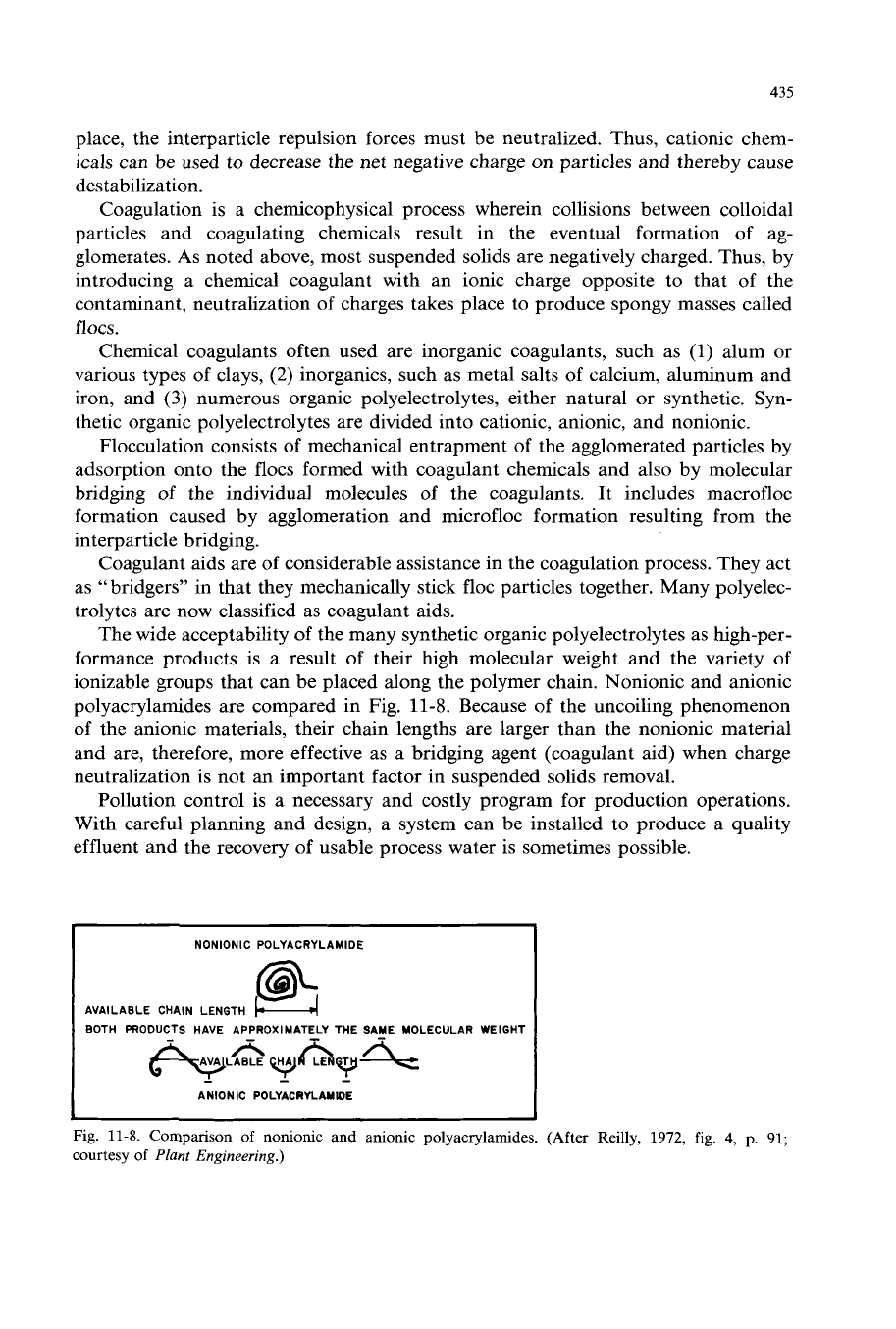
435
place, the interparticle repulsion forces must be neutralized. Thus, cationic chem-
icals can be used to decrease the net negative charge on particles and thereby cause
destabilization.
Coagulation is a chemicophysical process wherein collisions between colloidal
particles and coagulating chemicals result in the eventual formation of ag-
glomerates.
As
noted above, most suspended solids are negatively charged. Thus, by
introducing a chemical coagulant with an ionic charge opposite to that of the
contaminant, neutralization of charges takes place to produce spongy masses called
flocs.
Chemical coagulants often used are inorganic coagulants, such as
(1)
alum or
various types of clays,
(2)
inorganics, such as metal salts of calcium, aluminum and
iron, and
(3)
numerous organic polyelectrolytes, either natural or synthetic. Syn-
thetic organic polyelectrolytes are divided into cationic, anionic, and nonionic.
Flocculation consists of mechanical entrapment of the agglomerated particles by
adsorption onto the flocs formed with coagulant chemicals and also by molecular
bridging of the individual molecules of the coagulants.
It
includes macrofloc
formation caused by agglomeration and microfloc formation resulting from the
interparticle bridging.
Coagulant aids are of considerable assistance in the coagulation process. They act
as “bridgers” in that they mechanically stick floc particles together. Many polyelec-
trolytes are now classified as coagulant aids.
The wide acceptability
of
the many synthetic organic polyelectrolytes as high-per-
formance products is a result
of
their hgh molecular weight and the variety of
ionizable groups that can be placed along the polymer chain. Nonionic and anionic
polyacrylamides are compared in Fig.
11-8.
Because of the uncoiling phenomenon
of the anionic materials, their chain lengths are larger than the nonionic material
and are, therefore, more effective as a bridging agent (coagulant aid) when charge
neutralization is not an important factor in suspended solids removal.
Pollution control is a necessary and costly program for production operations.
With careful planning and design, a system can be installed to produce a quality
effluent and the recovery of usable process water is sometimes possible.
NONlONlC POLYACRYLAMIDE
@
&pL&yA+
AVAILABLE CHAIN LENGTH
BOTH PRODUCTS HAVE APPROXIMATELY THE SAME MOLECULAR
WEIGHT
ANIONIC POLYACRYLAMDE
Fig.
11-8.
Comparison
of
nonionic and anionic polyacrylamides. (After Reilly,
1972,
fig.
4,
p.
91;
courtesy
of
Plant Engineering.)
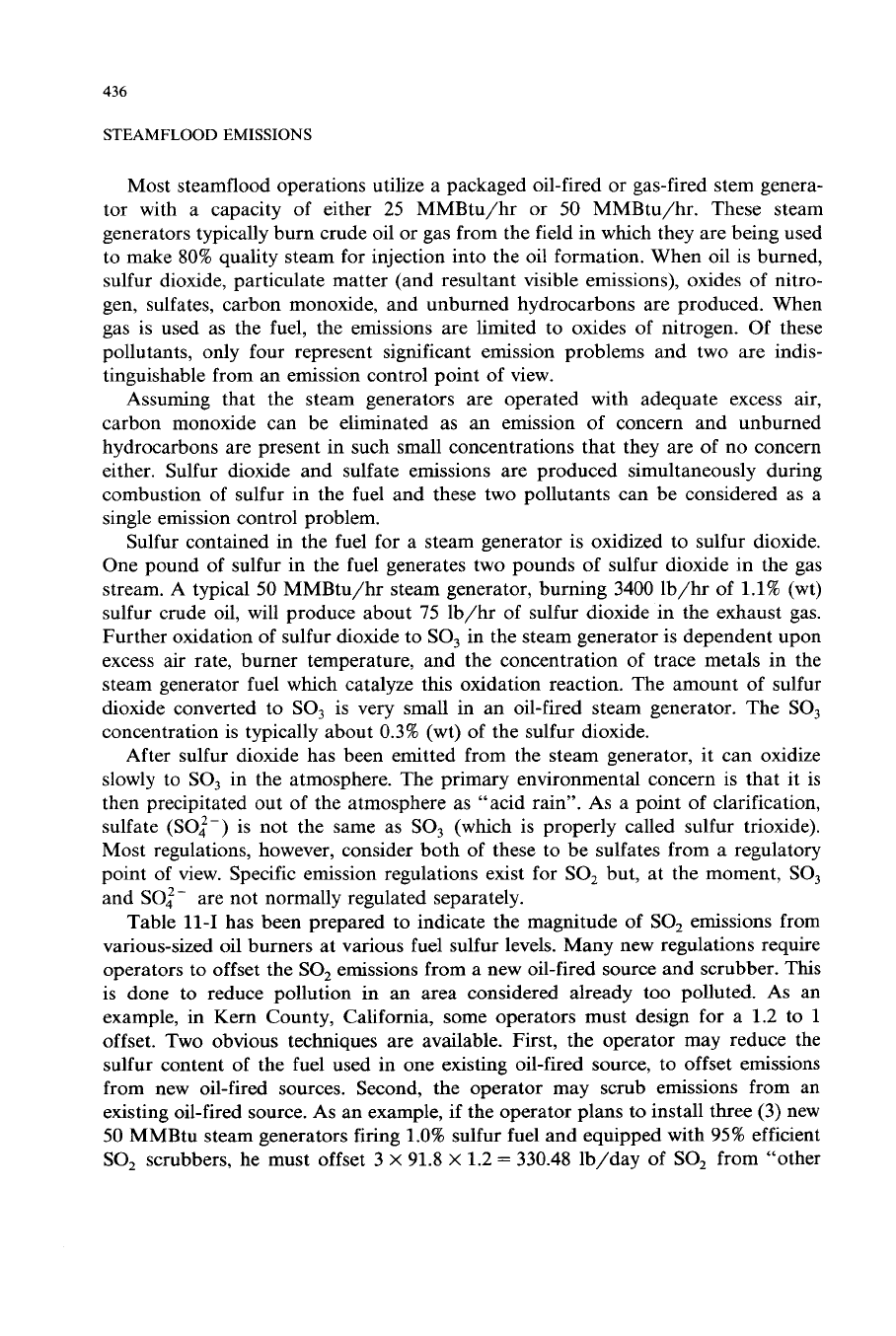
436
STEAMFLOOD
EMISSIONS
Most steamflood operations utilize a packaged oil-fired or gas-fired stem genera-
tor with a capacity of either
25
MMBtu/hr or
50
MMBtu/hr. These steam
generators typically burn crude oil or gas from the field in which they are being used
to make
80%
quality steam for injection into the oil formation. When oil is burned,
sulfur dioxide, particulate matter (and resultant visible emissions), oxides of nitro-
gen, sulfates, carbon monoxide, and unburned hydrocarbons are produced. When
gas is used as the fuel, the emissions are limited to oxides of nitrogen. Of these
pollutants, only four represent significant emission problems and two are indis-
tinguishable from an emission control point of view.
Assuming that the steam generators are operated with adequate excess air,
carbon monoxide can be eliminated as an emission of concern and unburned
hydrocarbons are present in such small concentrations that they are of no concern
either. Sulfur dioxide and sulfate emissions are produced simultaneously during
combustion of sulfur in the fuel and these two pollutants can be considered as a
single emission control problem.
Sulfur contained in the fuel for a steam generator is oxidized to sulfur dioxide.
One pound of sulfur in the fuel generates two pounds of sulfur dioxide in the gas
stream. A typical 50 MMBtu/hr steam generator, burning 3400 lb/hr of 1.1% (wt)
sulfur crude oil, will produce about
75
lb/hr of sulfur dioxide in the exhaust gas.
Further oxidation of sulfur dioxide to
SO,
in the steam generator is dependent upon
excess air rate, burner temperature, and the concentration of trace metals in the
steam generator fuel which catalyze this oxidation reaction. The amount of sulfur
dioxide converted to
SO,
is very small in an oil-fired steam generator. The
SO,
concentration is typically about 0.3% (wt) of the sulfur dioxide.
After sulfur dioxide has been emitted from the steam generator, it can oxidize
slowly to
SO,
in the atmosphere. The primary environmental concern is that it is
then precipitated out of the atmosphere as “acid rain”.
As
a point of clarification,
sulfate
(SO:-)
is not the same as
SO,
(which is properly called sulfur trioxide).
Most regulations, however, consider both of these to be sulfates from a regulatory
point of view. Specific emission regulations exist for
SO,
but, at the moment,
SO,
and
SO:-
are not normally regulated separately.
Table
11-1
has been prepared to indicate the magnitude of
SO,
emissions from
various-sized oil burners at various fuel sulfur levels. Many new regulations require
operators to offset the
SO,
emissions from a new oil-fired source and scrubber.
This
is done to reduce pollution
in
an area considered already too polluted.
As
an
example, in Kern County, California, some operators must design for a 1.2 to
1
offset. Two obvious techniques are available. First, the operator may reduce the
sulfur content of the fuel used in one existing oil-fired source, to offset emissions
from new oil-fired sources. Second, the operator may scrub emissions from an
existing oil-fired source.
As
an example,
if
the operator plans to install three (3) new
50 MMBtu steam generators firing 1.0% sulfur fuel and equipped with 95% efficient
SO,
scrubbers, he must offset 3
x
91.8
x
1.2
=
330.48 lb/day of
SO,
from “other
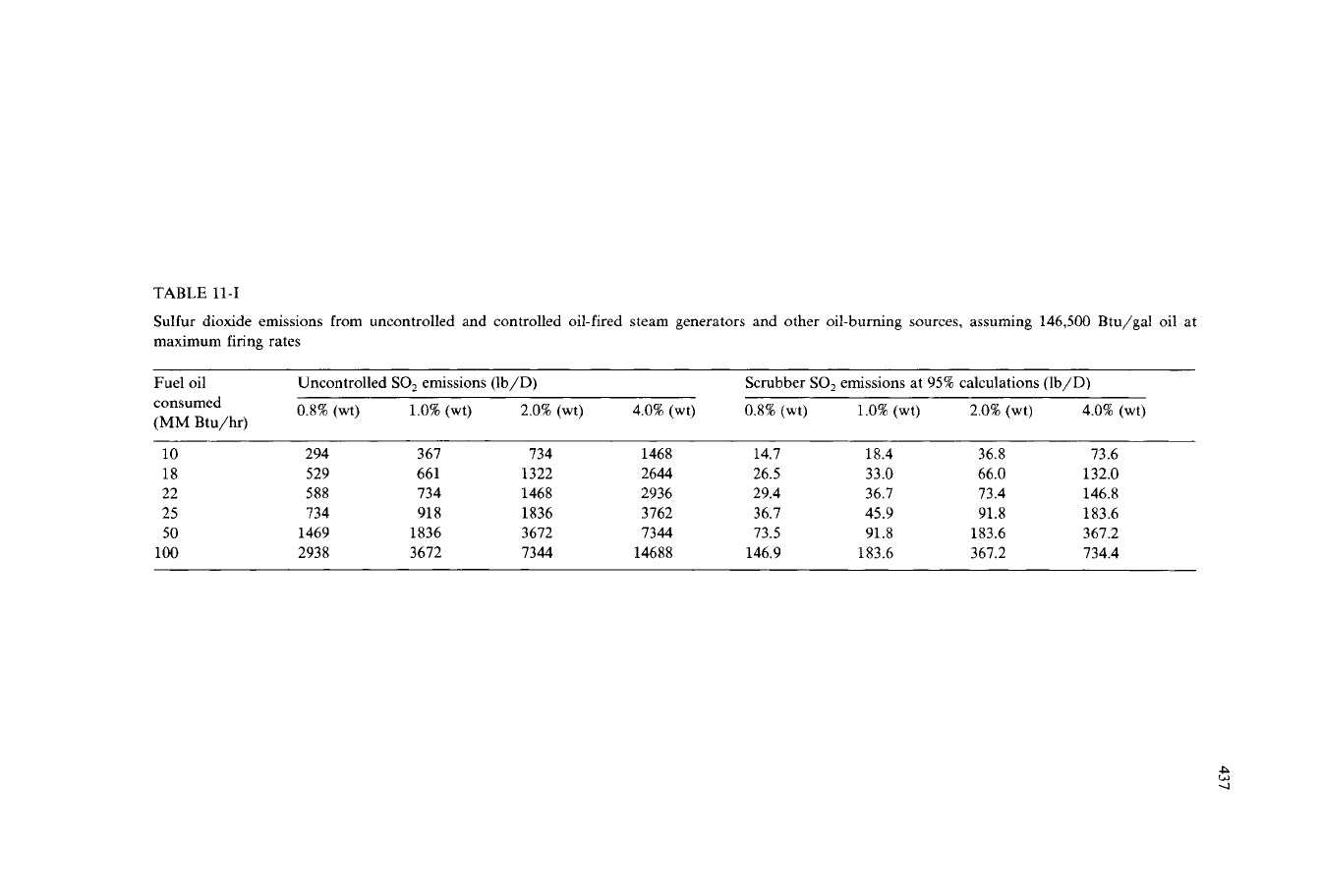
TABLE
11-1
Sulfur dioxide emissions
from
uncontrolled and controlled oil-fired steam generators and other oil-burning sources, assuming
146,500
Btu/gal oil
at
maximum firing rates
Fuel oil
consumed
(MM
Btu/hr)
Uncontrolled
SO,
emissions (lb/D)
0.8%
(wt)
1.0%
(wt)
2.0%
(wt)
4.0%
(wt)
0.8%
(wt)
1.0%
(wt)
2.0%
(wt)
4.0%
(wt)
Scrubber
SO,
emissions at
95%
calculations (lb/D)
10 294 361 134 1468 14.7 18.4 36.8 13.6
18 529 661 1322 2644
26.5
33.0
66.0 132.0
22 588 134 1468 2936 29.4 36.1 13.4 146.8
25 134 918 1836
3162 36.1 45.9 91.8 183.6
50 1469 1836 3612
1344 13.5
91.8 183.6 361.2
100 2938 3612 7344
14688 146.9
183.6 361.2 734.4
P
W
4
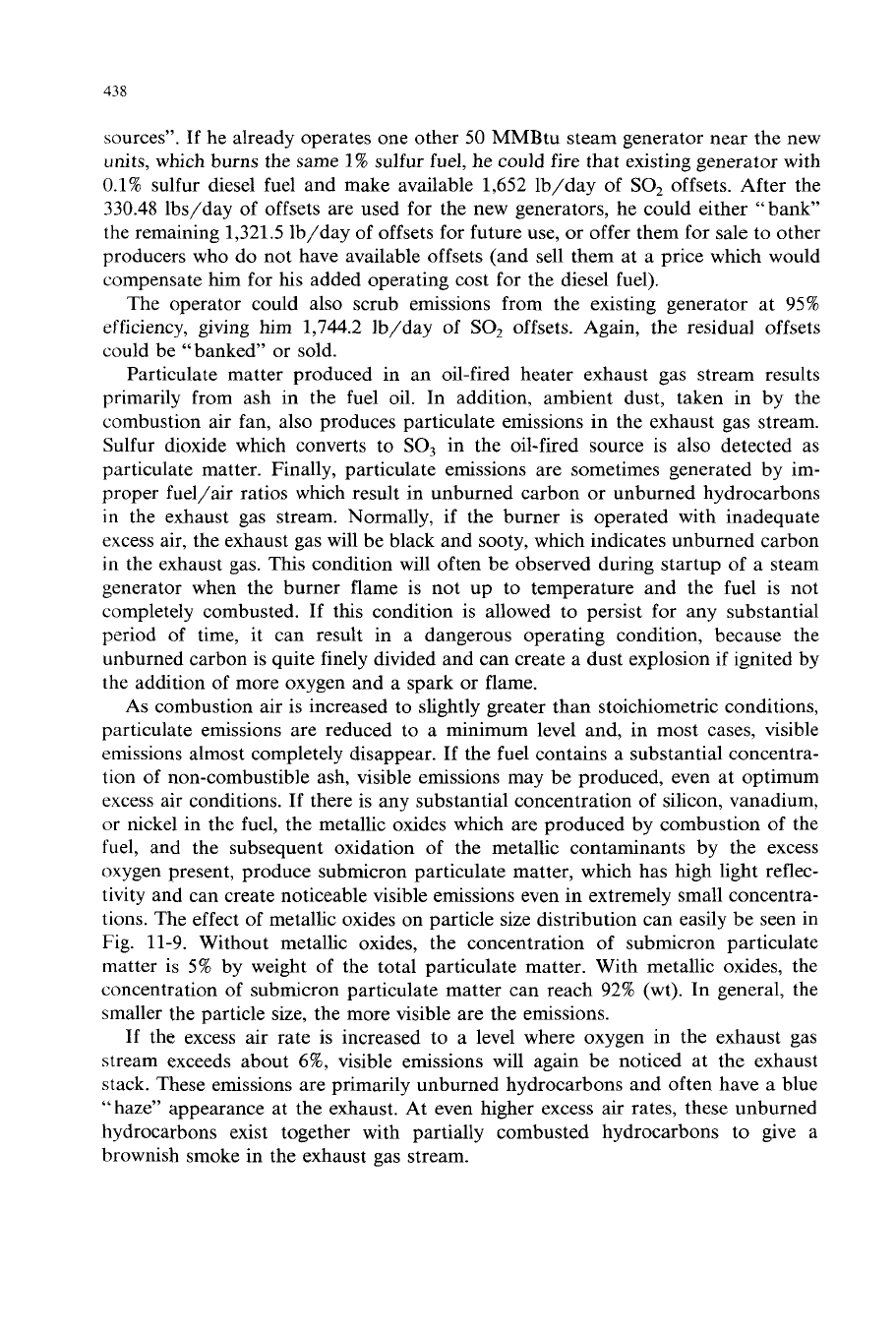
438
sources”. If he already operates one other
50
MMBtu steam generator near the new
units, which burns the same
1%
sulfur fuel, he could fire that existing generator with
0.1%
sulfur diesel fuel and make available 1,652 lb/day of
SO,
offsets. After the
330.48
lbs/day of offsets are used for the new generators, he could either “bank”
the remaining 1,321.5 lb/day of offsets for future use, or offer them for sale to other
producers who do not have available offsets (and sell them at a price which would
compensate him for his added operating cost for the diesel fuel).
The operator could also scrub emissions from the existing generator at 95%
efficiency, giving him
1,744.2
lb/day of
SO,
offsets. Again, the residual offsets
could be “banked” or sold.
Particulate matter produced in an oil-fired heater exhaust gas stream results
primarily from ash in the fuel oil. In addition, ambient dust, taken in by the
combustion air fan, also produces particulate emissions in the exhaust gas stream.
Sulfur dioxide which converts to
SO,
in the oil-fired source
is
also detected as
particulate matter. Finally, particulate emissions are sometimes generated by im-
proper fuel/air ratios which result in unburned carbon or unburned hydrocarbons
in
the exhaust gas stream. Normally,
if
the burner is operated with inadequate
excess air, the exhaust gas will be black and sooty, which indicates unburned carbon
in the exhaust gas. This condition will often be observed during startup of a steam
generator when the burner flame is not up to temperature and the fuel is not
completely combusted. If this condition is allowed to persist for any substantial
period of time, it can result in a dangerous operating condition, because the
unburned carbon is quite finely divided and can create a dust explosion if ignited by
the addition of more oxygen and a spark or flame.
As combustion air is increased to slightly greater than stoichiometric conditions,
particulate emissions are reduced to a minimum level and, in most cases, visible
emissions almost completely disappear. If the fuel contains a substantial concentra-
tion of non-combustible ash, visible emissions may be produced, even at optimum
excess air conditions. If there is any substantial concentration of silicon, vanadium,
or
nickel in the fuel, the metallic oxides which are produced by combustion of the
fuel, and the subsequent oxidation of the metallic contaminants by the excess
oxygen present, produce submicron particulate matter, which has high light reflec-
tivity and can create noticeable visible emissions even in extremely small concentra-
tions. The effect of metallic oxides on particle size distribution can easily be seen in
Fig. 11-9. Without metallic oxides, the concentration of submicron particulate
matter is 5% by weight of the total particulate matter. With metallic oxides, the
concentration of submicron particulate matter can reach 92% (wt). In general, the
smaller the particle size, the more visible are the emissions.
If the excess air rate is increased to a level where oxygen in the exhaust gas
stream exceeds about 6%, visible emissions will again be noticed at the exhaust
stack. These emissions are primarily unburned hydrocarbons and often have a blue
“haze” appearance at the exhaust, At even higher excess air rates, these unburned
hydrocarbons exist together with partially combusted hydrocarbons to give
a
brownish smoke in the exhaust gas stream.
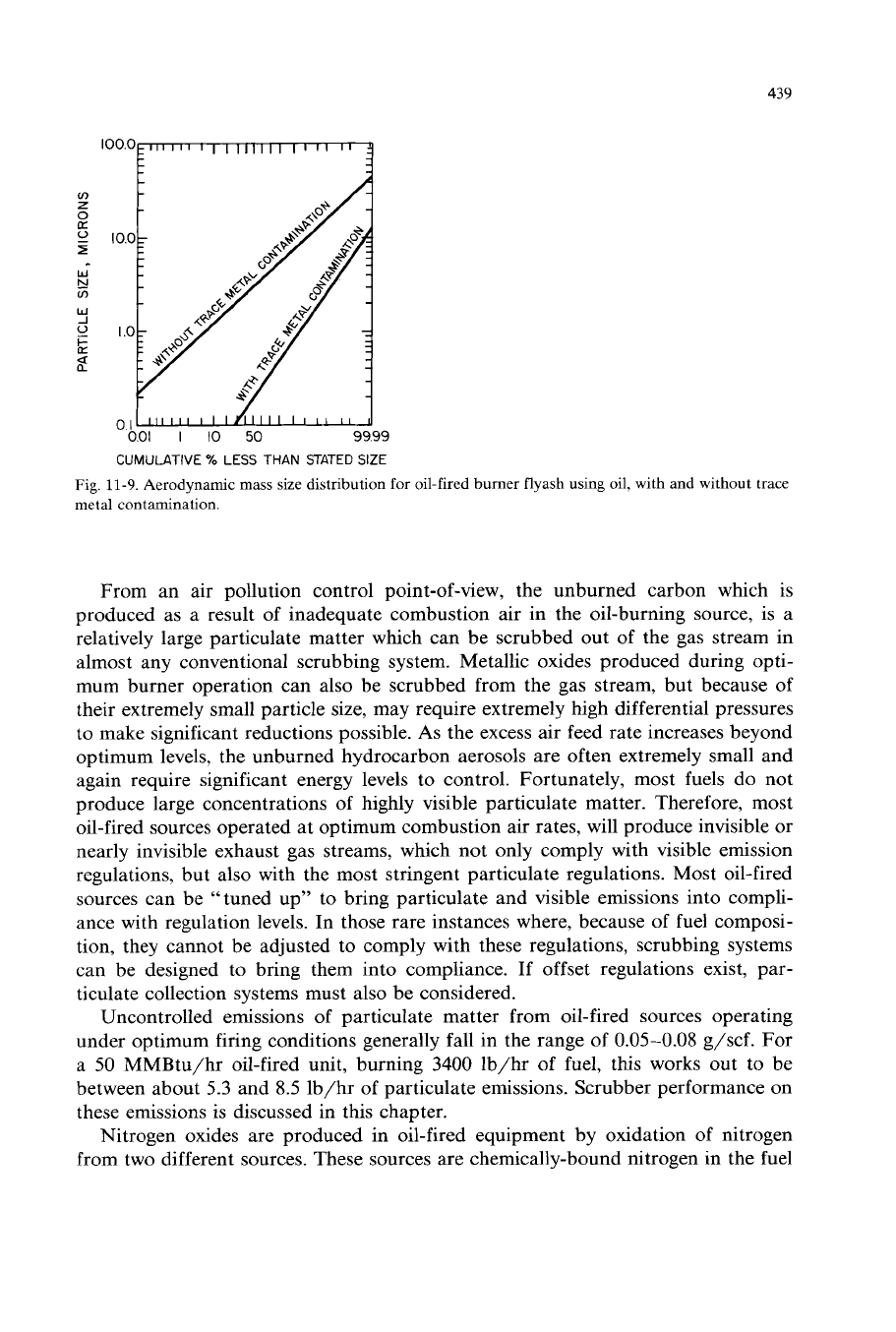
439
CUMULATIVE
%
LESS
THAN STATED SIZE
Fig.
11-9.
Aerodynamic
mass
size distribution for oil-fired burner flyash using oil, with and without trace
metal contamination.
From an air pollution control point-of-view, the unburned carbon which is
produced as a result of inadequate combustion air in the oil-burning source, is a
relatively large particulate matter which can be scrubbed out of the gas stream in
almost any conventional scrubbing system. Metallic oxides produced during opti-
mum burner operation can also be scrubbed from the gas stream, but because of
their extremely small particle size, may require extremely high differential pressures
to make significant reductions possible.
As
the excess air feed rate increases beyond
optimum levels, the unburned hydrocarbon aerosols are often extremely small and
again require significant energy levels to control. Fortunately, most fuels do not
produce large concentrations of highly visible particulate matter. Therefore, most
oil-fired sources operated at optimum combustion air rates, will produce invisible or
nearly invisible exhaust gas streams, which not only comply with visible emission
regulations, but also with the most stringent particulate regulations. Most oil-fired
sources can be “tuned up” to bring particulate and visible emissions into compli-
ance with regulation levels. In those rare instances where, because of fuel composi-
tion, they cannot be adjusted to comply with these regulations, scrubbing systems
can be designed to bring them into compliance. If offset regulations exist, par-
ticulate collection systems must also be considered.
Uncontrolled emissions of particulate matter from oil-fired sources operating
under optimum firing conditions generally fall in the range
of
0.05-0.08
g/scf. For
a
50
MMBtu/hr oil-fired unit, burning
3400
lb/hr
of
fuel, this works out to be
between about
5.3
and
8.5
lb/hr of particulate emissions. Scrubber performance on
these emissions is discussed in this chapter.
Nitrogen oxides are produced in oil-fired equipment by oxidation of nitrogen
from two different sources. These sources are chemically-bound nitrogen in the fuel
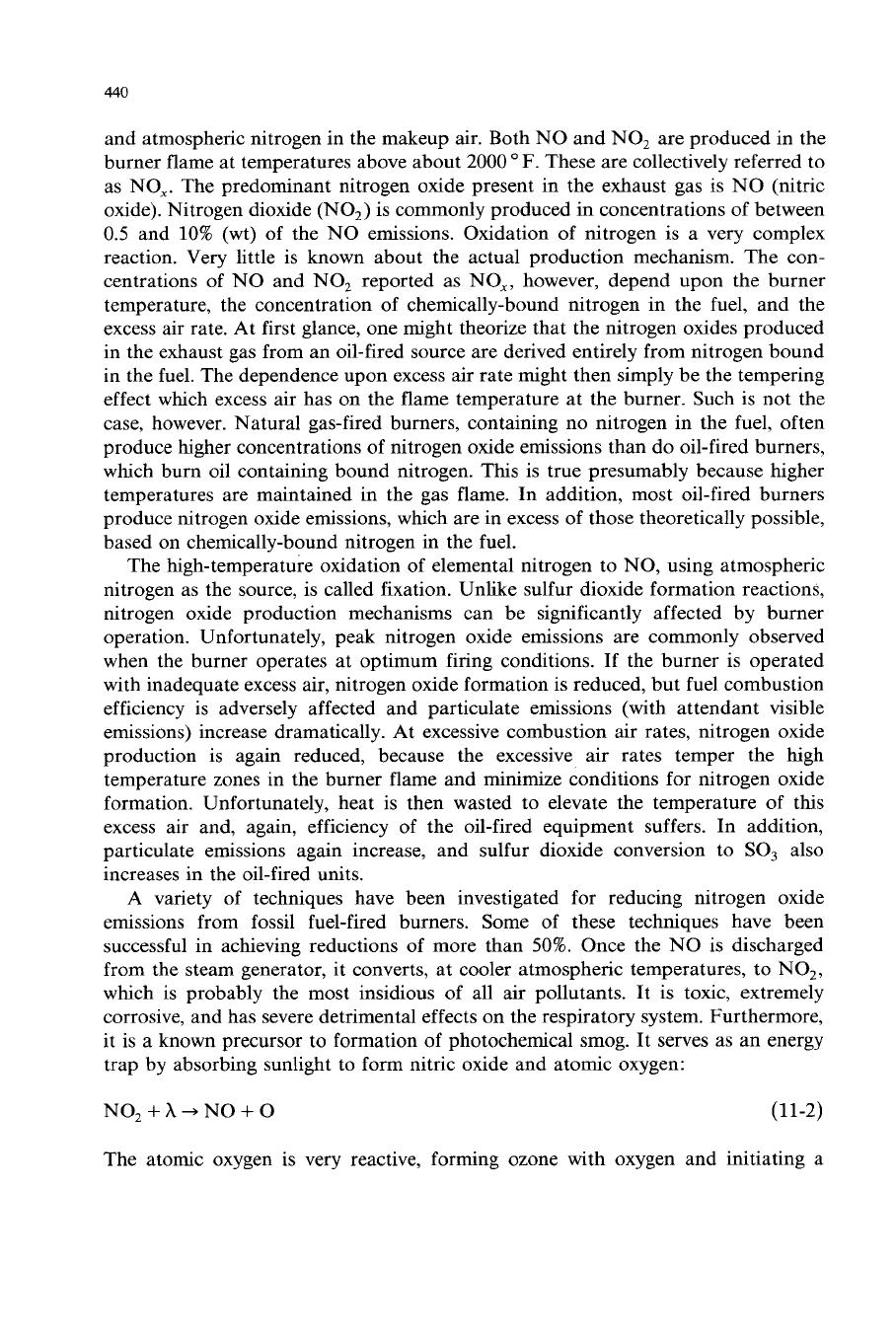
440
and atmospheric nitrogen in the makeup air. Both NO and
NO,
are produced in the
burner flame at temperatures above about
2000
O
F.
These are collectively referred to
as
NO,.
The predominant nitrogen oxide present in the exhaust gas is NO (nitric
oxide). Nitrogen dioxide (NO,) is commonly produced in concentrations
of
between
0.5
and
10%
(wt) of the
NO
emissions. Oxidation
of
nitrogen is a very complex
reaction. Very little is known about the actual production mechanism. The con-
centrations of
NO
and
NO,
reported as
NO,,
however, depend upon the burner
temperature, the concentration of chemically-bound nitrogen in the fuel, and the
excess air rate. At first glance, one might theorize that the nitrogen oxides produced
in the exhaust gas from an oil-fired source are derived entirely from nitrogen bound
in the fuel. The dependence upon excess air rate might then simply be the tempering
effect which excess air has on the flame temperature at the burner. Such is not the
case, however. Natural gas-fired burners, containing no nitrogen in the fuel, often
produce higher concentrations of nitrogen oxide emissions than do oil-fired burners,
which burn oil containing bound nitrogen. This is true presumably because higher
temperatures are maintained in the gas flame. In addition, most oil-fired burners
produce nitrogen oxide emissions, which are in excess of those theoretically possible,
based on chemically-bound nitrogen in the fuel.
The high-temperature oxidation of elemental nitrogen to
NO,
using atmospheric
nitrogen as the source, is called fixation. Unlike sulfur dioxide formation reactions,
nitrogen oxide production mechanisms can be significantly affected by burner
operation. Unfortunately, peak nitrogen oxide emissions are commonly observed
when the burner operates at optimum firing conditions. If the burner is operated
with inadequate excess air, nitrogen oxide formation is reduced, but fuel combustion
efficiency is adversely affected and particulate emissions (with attendant visible
emissions) increase dramatically. At excessive combustion air rates, nitrogen oxide
production is again reduced, because the excessive air rates temper the high
temperature zones in the burner flame and minimize conditions for nitrogen oxide
formation. Unfortunately, heat is then wasted to elevate the temperature of this
excess air and, again, efficiency of the oil-fired equipment suffers. In addition,
particulate emissions again increase, and sulfur dioxide conversion to
SO,
also
increases in the oil-fired units.
A variety
of
techniques have been investigated for reducing nitrogen oxide
emissions from fossil fuel-fired burners. Some of these techniques have been
successful in achieving reductions of more than
50%.
Once the NO is discharged
from the steam generator, it converts, at cooler atmospheric temperatures, to
NO,,
which is probably the most insidious
of
all air pollutants. It is toxic, extremely
corrosive, and has severe detrimental effects on the respiratory system. Furthermore,
it is a known precursor to formation of photochemical smog. It serves as an energy
trap by absorbing sunlight to form nitric oxide and atomic oxygen:
NO,
+A
+
NO
+
0
(11-2)
The atomic oxygen is very reactive, forming ozone with oxygen and initiating a

441
number of secondary photochemical chain reactions with volatile hydrocarbons in
the atmosphere.
Sulfur
dioxide
control
Initial efforts to control sulfur dioxide emissions from fossil fuel-fired equipment
were made in England when sulfur dioxide, mixed with “London fog”, created
sulfuric acid clouds, which resulted in a number of deaths among London residents
in the
1940’s.
Very active sulfur dioxide control programs are now underway in the
United States, Canada, Japan and Germany. In the United States, the primary
attention has been given to coal-fired utility plants. In Germany and in Canada,
attention has been directed primarily to coal-burning sources. For about
25
years,
sulfur dioxide control technology has improved and has now developed to a point
where very successful commercial installations have been made on a number of
utility and industrial boilers.
Because of the availability of lime and limestone in most areas in the United
States where coal is used as a fuel for utility plants, most sulfur dioxide removal
systems have involved lime or limestone as the reactant for the
SO2.
Scaling
problems in the scrubbers, tanks and piping are often encountered due to the
insolubility of calcium sulfite and sulfate, which are the reaction products. Very
difficult materials handling problems also result from use of lime or limestone
slurries for absorption of sulfur dioxide.
As
a result, much attention has been given
to development of sodium hydroxide or sodium carbonate-based systems, which use
water soluble absorbers and keep the calcium out of the scrubbing loop. The most
successful of the water soluble absorption systems is the double alkali process
(Brady and Legatski,
1978).
This system utilizes either sodium hydroxide or soda
ash as a makeup chemical, but then utilizes slaked lime Ca(OH), in a secondary
reaction loop to precipitate calcium sulfite dihydrate (CaSO,
-
2
H,O),
while simul-
taneously regenerating the absorption solution. Only small quantities of the rela-
tively expensive sodium hydroxide or soda ash are required to act as makeup
chemicals for sodium salts, which are dragged out of the solution as entrainment in
the filter cake. This system has been highly successful in controlling emissions from
both oil- and coal-fired industrial and utility sources. One such system has been
installed on multiple steam generators in the oilfields (Sachtschale,
1980).
When very small combustion sources are considered for sulfur dioxide removal,
as in the case
of
individual oilfield heaters, the lime and limestone scrubbing
systems are simply not economically feasible because of the capital and operating
costs of the materials handling equipment required to produce slurries of either lime
or limestone. In addition, because the oil-fired systems in the oilfields are operated
unattended, slurry systems are not adequately reliable, due to pipe and nozzle
pluggage and extreme sensitivity to operating conditions, to prevent scale formation.
The “toothpaste-like” waste product is also difficult to handle and very expensive to
dispose of.
Because of the high capital cost associated with the secondary chemical reactor,
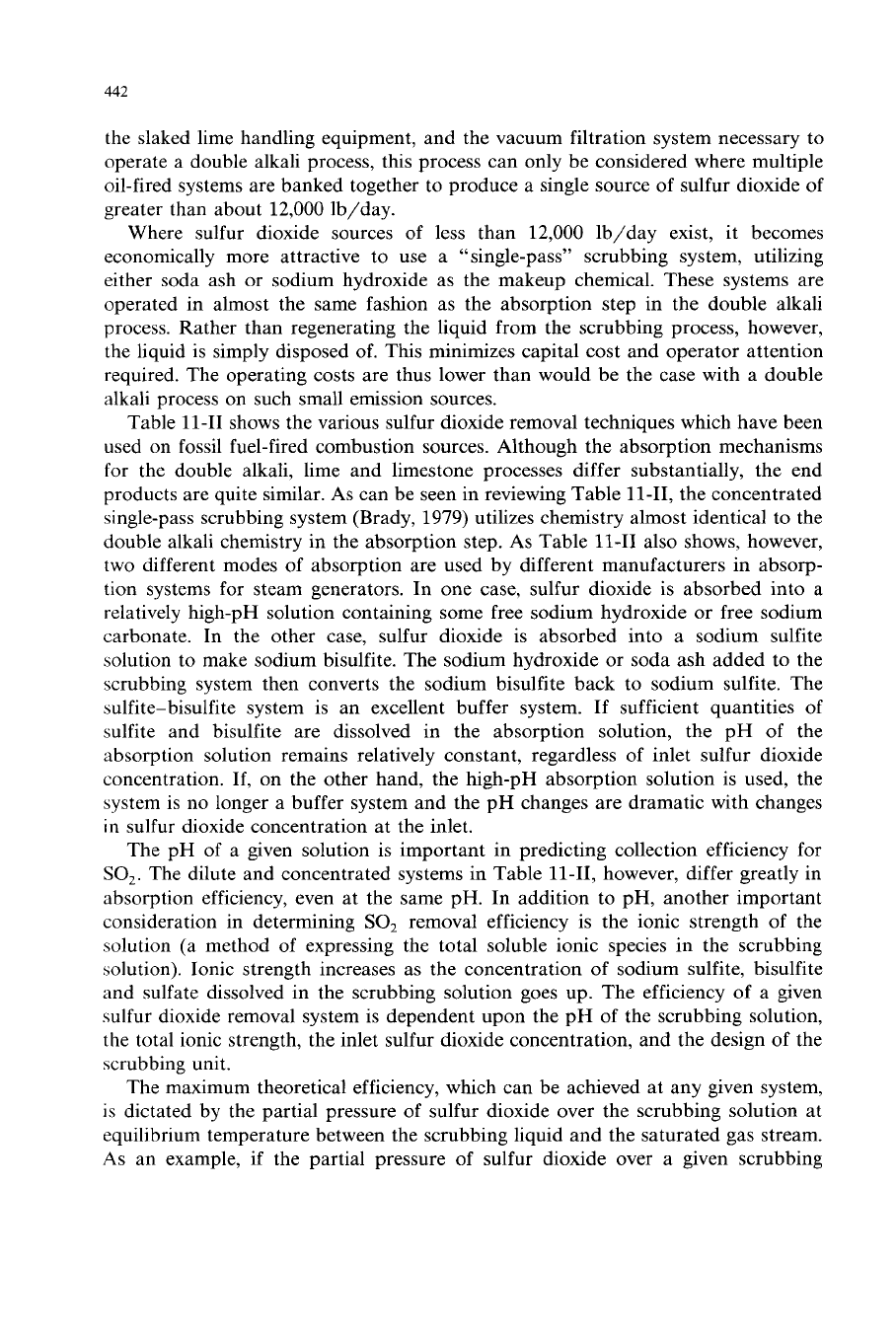
442
the slaked lime handling equipment, and the vacuum filtration system necessary to
operate a double alkali process, this process can only be considered where multiple
oil-fired systems are banked together to produce a single source of sulfur dioxide
of
greater than about 12,000 lb/day.
Where sulfur dioxide sources of less than 12,000 lb/day exist, it becomes
economically more attractive to use a “single-pass’’ scrubbing system, utilizing
either soda ash or sodium hydroxide as the makeup chemical. These systems are
operated in almost the same fashion as the absorption step in the double alkali
process. Rather than regenerating the liquid from the scrubbing process, however,
the liquid is simply disposed of. This minimizes capital cost and operator attention
required. The operating costs are thus lower than would be the case with a double
alkali process on such small emission sources.
Table 11-11 shows the various sulfur dioxide removal techniques which have been
used on fossil fuel-fired combustion sources. Although the absorption mechanisms
for the double alkali, lime and limestone processes differ substantially, the end
products are quite similar.
As
can be seen in reviewing Table 11-11, the concentrated
single-pass scrubbing system (Brady, 1979) utilizes chemistry almost identical to the
double alkali chemistry in the absorption step.
As
Table
11-11
also shows, however,
two different modes of absorption are used by different manufacturers in absorp-
tion systems for steam generators. In one case, sulfur dioxide is absorbed into a
relatively high-pH solution containing some free sodium hydroxide or free sodium
carbonate. In the other case, sulfur dioxide is absorbed into a sodium sulfite
solution to make sodium bisulfite. The sodium hydroxide or soda ash added to the
scrubbing system then converts the sodium bisulfite back to sodium sulfite. The
sulfite-bisulfite system is an excellent buffer system. If sufficient quantities
of
sulfite and bisulfite are dissolved in the absorption solution, the pH
of
the
absorption solution remains relatively constant, regardless of inlet sulfur dioxide
concentration. If, on the other hand, the high-pH absorption solution is used, the
system is no longer a buffer system and the pH changes are dramatic with changes
in
sulfur
dioxide concentration at the inlet.
The pH of a given solution is important in predicting collection efficiency for
SO,.
The dilute and concentrated systems in Table 11-11, however, differ greatly in
absorption efficiency, even at the same pH. In addition to pH, another important
consideration in determining
SO,
removal efficiency is the ionic strength
of
the
solution (a method of expressing the total soluble ionic species in the scrubbing
solution). Ionic strength increases as the concentration
of
sodium sulfite, bisulfite
and sulfate dissolved in the scrubbing solution goes up. The efficiency of a given
sulfur dioxide removal system is dependent upon the
pH
of the scrubbing solution,
the total ionic strength, the inlet sulfur dioxide concentration, and the design of the
scrubbing unit.
The maximum theoretical efficiency, which can be achieved at any given system,
is
dictated by the partial pressure of sulfur dioxide over the scrubbing solution at
equilibrium temperature between the scrubbing liquid and the saturated gas stream.
As
an example, if the partial pressure of sulfur dioxide over a given scrubbing
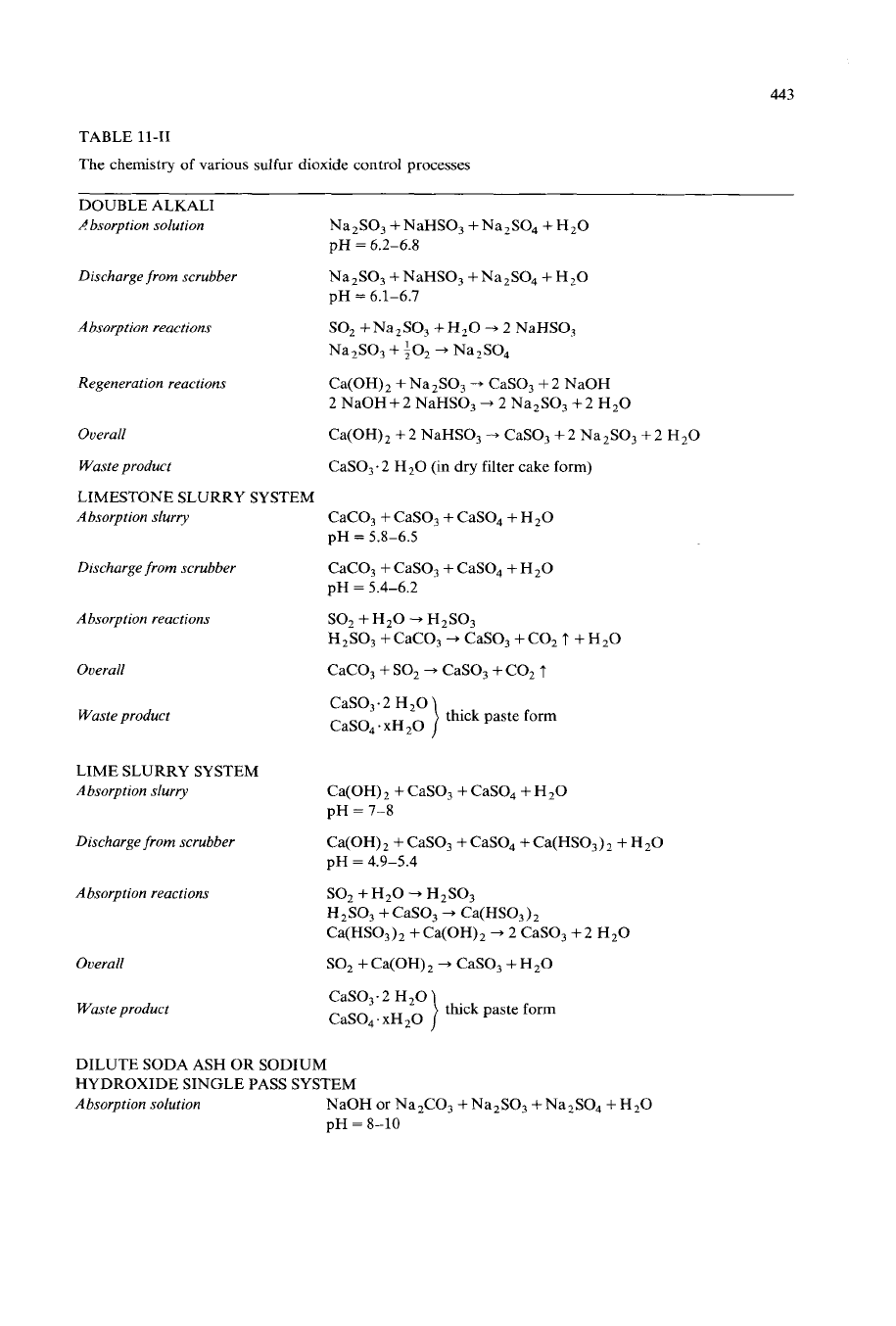
443
TABLE
11-11
The chemistry
of
various sulfur dioxide control processes
DOUBLE ALKALI
Absorption solution
Discharge from scrubber
Absorption reactions
Regeneration reactions
Overall
Waste product
LIMESTONE SLURRY SYSTEM
Absorption slurry
Discharge from scrubber
Absorption reactions
Overall
Waste product
Na,SO, +NaHSO, +Na,SO, +H20
pH
=
6.2-6.8
Na,SO, +NaHSO, +Na,SO,+H,O
pH
=
6.1-6.7
SO,
+Na,SO, +H,O
+
2 NaHSO,
Na,SO,
+
i02
+
Na,SO,
Ca(OH), +Na,SO,
-+
CaSO,
+2
NaOH
2
NaOHf2 NaHSO,
+
2 Na,SO,
+2
H,O
Ca(OH),
+
2
NaHSO,
-+
CaSO,
+
2
Na,SO,
+
2
H,O
CaS0,.2 H,O (in dry filter cake form)
CaCO,
+
CaSO,
+
CaSO,
+
H,O
pH
=
5.8-6.5
CaCO,
+
CaSO,
+
CaSO,
+
H,O
pH
=
5.4-6.2
SO,
+
H,O
+
H,SO,
H,SO,
+
CaCO,
--t
CaSO,
+
CO,
T
+
H,O
CaCO,
+
SO,
+
CaSO,
+
CO,
1
thick paste form
I
CaS0,.2 H,O
CaSO,
.
xH
,O
LIME SLURRY SYSTEM
Absorption slurty
Discharge
from
scrubber
Absorption reactions
Overall
Waste product
Ca(OH),
+
CaSO,
+
CaSO,
+
H,O
pH
=
7-8
Ca(OH),
+
CaSO,
+
CaSO,
+
Ca(HSO,),
+
H,O
pH
=
4.9-5.4
SO,
+
H20
-
H,SO,
H,SO, +CaSO,
-+
Ca(HSO,),
Ca(HSO,), +Ca(OH),
-+
2 CaSO,
+2
H,O
SO,
+
Ca(0H)
,
-+
CaSO,
+
H,O
thck paste form
CaS03.2 H,O
CaSO,
.
xH,O
I
DILUTE SODA
ASH
OR
SODIUM
HYDROXIDE
SINGLE
PASS SYSTEM
Absorption solution
NaOH or Na,C03 +Na,SO, +Na2S0, +H,O
pH
=
8-10

444
TABLE
11-11
(continued)
Discharge from scrubber
Na,SO, +NaHSO, +Na,S04 +H,O
pH
=
4-5
SO,
+
2
NaOH
+
Na,SO,
+
H,O
or
SO,
+Na,CO,
+
Na,SO,
+CO,
f
and
SO,
+
Na,SO,
+
H,O
+
2
NaHSO,
Na,SO,
+
:02
+
Na,SO,
Absorption reactions
Waste product
Na,SO, +NaHSO, +Na,S04 +H,O in dilute
(less than
5%
dissolved
solids)
solution
CONCENTRATED SODA ASH
OR
SODIUM HYDROXIDE SINGLE PASS SYSTEM
Absorption solution
Na,SO, +NaHSO, +Na,S04 +H,O
pH
=
6.2-6.9
Discharge from scrubber
Na2S0, +NaHSO, +Na,SO,
+
H20
pH
=
6.0-6.8
SO,
+Na,SO, +H,O
+
2
NaHSO,
Na,SO,
+
;O2
+
Na2S04
Absorption reactions
Chemical addition
-Waste product
NaOH+NaHSO,
+
Na,SO, +H,O
Na,CO,
+
2
NaHSO,
+
2
Na,SO,
+
CO,
t
+
H,O
Na,SO, +NaSHO, +Na2S04 +H,O
in
concentrated
(greater than
5%
dissolved solids) solution
solution is
30
ppm (vol), and the scrubbing unit is mechanically capable of
achieving equilibrium conditions between the gas and the liquid at its discharge, it
would be possible to achieve
90%
collection efficiency or greater only on inlet sulfur
dioxide concentrations of not less than
300
ppm (vol).
Ninety-five percent efficiency could be achieved only on inlet gas streams with an
SO,
concentration in excess of
600
ppm (vol) (Sachtschale,
1980).
Likewise,
97%
collection efficiency could be achieved only on inlet gas streams having a sulfur
dioxide concentration in excess of
1000
ppm (vol). Thus, while a given scrubbing
system may, in fact, be
90,
95,
or
97%
efficient under given operating conditions, if
the inlet sulfur dioxide concentration
is
not sufficiently high, the scrubber may not
achieve the advertised efficiency levels. It is far easier to reduce a
1000
ppm
SO,
concentration to
50
ppm
(95%
collection) than it is to reduce a
200
ppm
SO,
concentration to
10
ppm
(95%
collection). Figure
11-10
shows actual
SO,
vapor
pressure measurements at equilibrium conditions over a typical scrubbing solution
at various sulfite/bisulfite molar ratios.
An equally important design consideration
is
the quantity of removed sulfur
dioxide which can be discharged from the scrubbing system in a given unit volume
